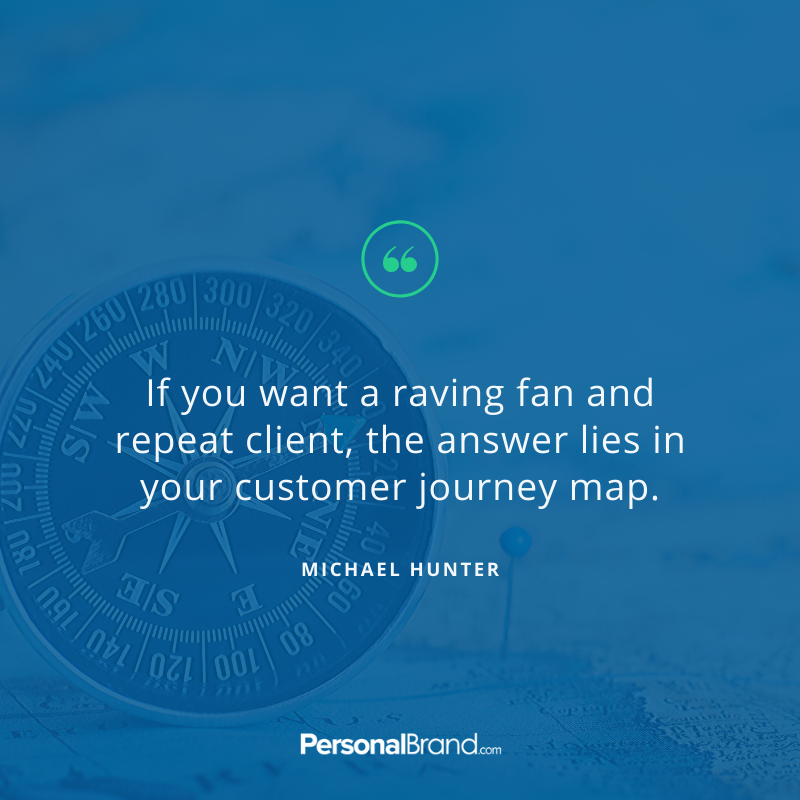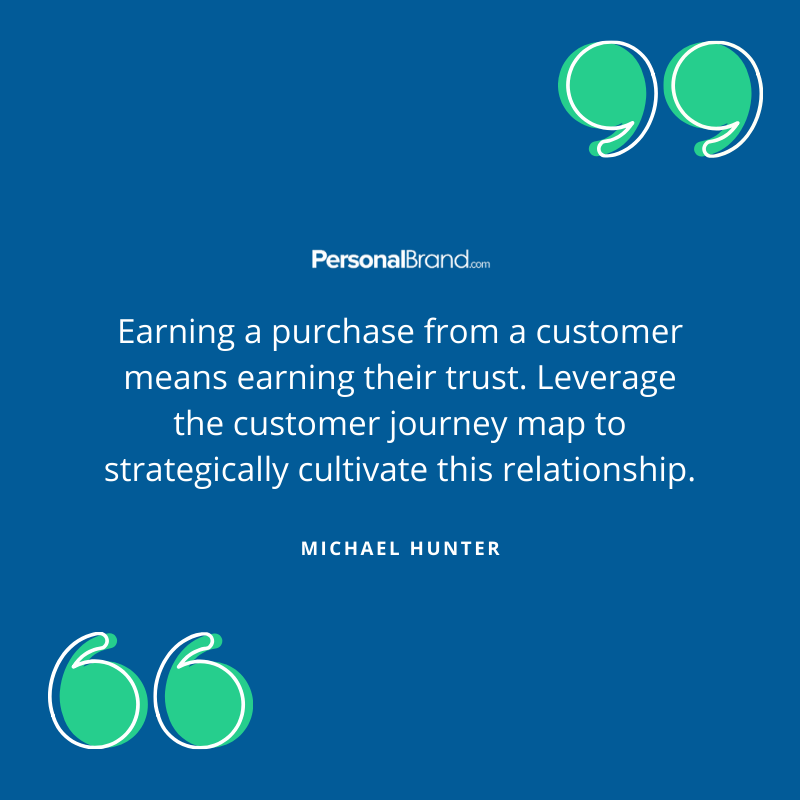What is Customer Journey Mapping, and How Will it Strengthen Your Personal Brand?
How well do you know your prospective customer?
Could you identify him at a cocktail party from across the room? Do you empathize with her frustrations? Could you summarize the process that he’ll take through the marketing funnel from a learner to a shopper to a buyer until he’s your raving fan?
Earning a purchase from a customer means earning their trust. It means empathizing with their struggles and addressing their needs at every point throughout their process of moving from strangers to raving fans.
To help you better understand all the potential points of engagement that you could have with prospects throughout the continuum of their awareness, education, and purchase process, you need a customer journey map.
If X marks the spot of buried treasure, the end of your customer journey map will precisely pinpoint what you need to do to earn the trust and patronage of your most valuable prospects.
What is a Customer Journey Map?
A customer journey map tells the story of your customer’s experience with your personal brand. Be prepared, however, because not all customer journey maps start and end with a smooth, coherent story. These tools are often used to inform brand leaders about critical areas of improvement and places where their brand fails to delight their customers.
A customer journey map is a visual depiction of every experience someone has with your personal brand.
Track them from the moment they become aware of your offering through their research and purchase decision-making process, through new customer onboarding and upsell. The visual mapping process helps to identify gaps in messaging or service delivery, siloes between departments, or any other pitfalls that could create anything other than stellar experiences for your prospects and customers.
Rave and Repeat
We want to emphasize that the tail end of the customer journey map—the customer’s experience—is just as critical as the beginning—the prospect’s experience. While many entrepreneurs maintain a keen focus on filling their marketing funnel, know that acquiring a new customer is anywhere from five to 25 times more expensive than retaining an existing one. At the same time, increasing customer retention rates by only five percent can increase profits by 25 to 95 percent.
Existing customers are tremendously valuable and should never be forgotten or disregarded once their purchase is complete.
To earn their repeat business, however, they need to have a positive experience with your personal brand.
The development of a customer journey map can help ensure you are executing your administrative process and engaging with customers to ensure they will become a raving, repeat fan.
To build a customer journey map for your personal brand, review our get-started tips below.
Identify All Personas
Start your customer journey map by identifying all your personas. If your prospect and customer purchase experiences deviate radically among personas, then you may want to consider creating separate customer journey maps for each audience.
In most cases, your various personas will learn about your personal brand and become a customer using the same communication channels.
You can, therefore, incorporate them into a single customer journey map.
The exception to this may be if you serve extremely different audiences with different products, and market them widely different.
For example, if you are a personal trainer who offers adult fitness classes, you may market your courses via social media and your website. These customers may experience a different journey from other customers who sign up for your Silver Sneakers 65 and older monthly nutrition and wellness class, who most commonly learn about your course from the monthly fitness column you write for Healthy Aging magazine.
Segment the Customer Journey into Phases
Remember to create your customer journey map from your customer’s point of view—not yours. Your segmented customer phases, therefore, should not reflect your internal administrative workflows (e.g., marketing, onboarding, accounting, customer service), but rather the customer’s problem-solving experiences (e.g., learner, shopper, buyer, customer, community member, raving fan and referrer, repeat customer, subscription member).
Identify Every Touchpoint
The customer journey map is not something that can be scribbled on a cocktail napkin. Your final document should be highly detailed as it should include every single time, place, and communication channel in which a customer interacts with your personal brand throughout the buying process. Expect to include such touchpoints as:
- Traditional and online advertising
- Your website
- Social media
- Third-party media coverage
- Influencer referrals
- Content marketing
- Search engine results
- Product packaging
- Event experience
- Referrals
It’s highly likely that your touchpoint analysis will reveal that a significant number of engagement channels between your personal brand and prospects and customers are digital. Accordingly to McKinsey & Company, consumer journeys are steadily becoming more digitized.
The number of digital touchpoints between brands and consumers increases annually by 20 percent as more consumers begin their solution search online, and more Millennials and Gen Z shoppers strengthen their consumer influence.
Quantify Prospect and Customer Engagement
To get the most out of your customer journey map, go beyond a list of moments of engagement and dig into the metrics available to you from your customer relationship management (CRM) and content management system (CMS). Identify and assess such analytics as:
- Website traffic and primary origin channels. Understanding where the majority of your website traffic originates (e.g., organic search, social media, emails, referrals from influencers or trusted third parties, paid advertising), can help you strengthen marketing efforts.
- Customer service inquiries. For example, do you receive a significant number of inquiries from customers who sign up to attend your event with questions about details that are not included in their registration materials? Could such data portend a need to improve the communication process for event registrants?
Talk to Prospects, Customers, Former Customers, and Your Competitors’ Customers
We’ll spare you the adage about the risks that can befall one who assumes. The point is that you want to do more than build your customer journey map based on the experience you believe prospects and customers are having with your personal brand today. To create a useful and enlightening customer journey map, speak with a wide variety of individuals who can provide insights about various stages of the customer journey.
- Ask a prospect about their challenges, what information they were seeking that led to your personal brand, where they learned about your personal brand, and what their first impression was of your website.
- Ask a recent buyer how easy or difficult it was to complete their online purchase transaction.
- Ask a one-time buyer about their experience, and what would motivate them to make a repeat purchase?
- Ask a raving fan about how your methodology has enhanced his life.
- Ask someone who considered your services, but did not make a purchase, where your offering failed to address their needs.
If the idea of receiving negative (we mean constructive) feedback from any of these sources scares you, accept that some of the most valuable feedback you will receive is the kind that will help you strengthen your offering. Don’t avoid opportunities to speak to those who failed to become raving fans. You need their insights to fill the gaps in your customer journey map.
Align Your Customer Journey Map with Your Brand Statement
One of the key insights you should be able to glean from your customer journey map are disconnects between your personal brand statement and the reality of your customer’s experience. If, for example, you operate on a promise of simplifying the financial planning process, and you hear from customers that they left your training course feeling more confused and overwhelmed, then before they signed up, you’ve identified a critical disconnect and an area for methodology improvement.
Capture Customer Perceptions of their Experiences with Your Personal Brand Relative to Their Goals, Not Yours
Your goal for your personal brand may be to get as many people to sign up for your week-long mastermind course as possible, but your customer’s goal is to improve her self-confidence and take back control of her career.
Ensure you are asking questions and gaining insights about whether prospect and customer experiences with your personal brand helped them to reach their goals and improve their lives—for that should be your purpose.
Leverage Your Customer Journey Map as a Valuable Tool
Once you complete your customer journey map, don’t just put it in a drawer or file it into your digital archives. Use what you’ve learned to strengthen your marketing efforts, refine your messaging, pivot on your market positioning, and improve the customer service experience.
Use your customer journey map to prioritize improvement opportunities.
If, for example, your customer journey map reveals that 45 percent of prospects fail to convert to customers once they reach your sales page because of confusing messaging or misaligned price points, then you know where to begin to boost conversions and revenue.
Innovate and Iterate
Not only can your customer journey map be a tool to improve existing workflows and customer experiences, but you can also use it to ideate new solutions, market segments, educational content, and further productize your knowledge. During your interviews, ask prospects and customers such questions as:
- What information, had it been available, would have helped you throughout the process of solving your challenge?
- In what other areas of your life could I help you to meet your goals?
- Was there anything you were hoping to learn or accomplish in working with me that I failed to address?
Such questions will help you evolve your offering and expand your influence.
Share Your Learnings with Your Team
If you are running lean, then your customer journey map may be a tool only for you. If, however, you have scaled your organization to include the support of full-time or part-time team members, share your learnings and insights with them as well, especially with anyone who is customer-facing. Your customer journey map should enable you to ensure you are providing a streamlined user experience, which means all team members consistently deliver on your brand promise.
Customer Journey Mapping Tools
If you’re looking for a tool or online solution to help you ideate and create your customer journey map, consider the following online collaboration and visualization tools:
Final Advice
Your customer journey mapping experience should be an ideal mix of art and science.
Ultimately, your goal should be to understand better the people who give your personal brand a purpose so that you can better help them reach their goals and live a better life.
As you continue to evolve your marketing, productizing, and service approach, make sure to continually refer back to your customer journey map, refresh and reanalyze it, and ensure you remain focused on delivering the highest-quality customer engagement experiences.
If you’d like to learn more about the nuances of customer research, productizing your knowledge, and producing valuable content, click below to sign up for our Income + Impact Accelerator course today. Start My Course


Take It One Step Further
A personal brand is the best way to increase your impact, influence and income. Start building your personal brand today, we’re here to help!
For more, great content on how to build your personal brand, subscribe to our newsletter and join our private Personal Brand Builders community. You’ll never have worry about missing our latest and greatest tips, strategies, and advice for building your personal brand.
We hope you enjoyed this article. Follow us on Facebook, and Twitter for updates every time we publish!


